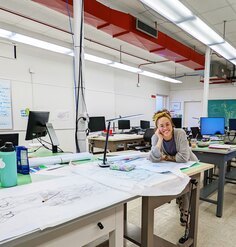Olmsted Scholar Feature: Streets -- Dwelling Place for the Common Good
By Dustin Smith, 2013 University Olmsted Scholar
The estranged relationship with the street exhibited by the modern man’s frivolous attempts at engaging it for means other than conveyance has largely meant the abandonment of American public life. Contemporary placemaking ideologies that imagine there can be infinite deconstruction and reorganization of the basic typological inventory of urban elements have been equally damaging regarding the role of the street as a public place and the street grid as a continuum of public space. This is disconcerting for the common good, which requires a public realm to bind us all together in the realization of a shared sense of dwelling.
My ensuing thesis investigation explored the degenerative role of the street in the public sphere of urban American landscapes, a causation of the dogmas and aims of Modernist design, planning, and management of the land. While the study’s methodology involved the critical examination of prominent theorists, an examination of phenomenological, morphological, and social factors related to the form and function of urban streets and the street grid was conducted in Annapolis, Maryland. The idea was to document a series of personal observations, narratives, photographs and diagrams to grapple with the everyday visual cues, patterns, and social evidence of streets reflective of the common good; in other words, the commitment to a life shared with others.
Historic Annapolis offers an urban pattern unique to colonial American town and city planning. Its resilience against urbanization coupled with a civic structure cognizant of place-making values related to the ancient notion of the polis and civitas made Annapolis an ideal setting to explore the public character of urban streets. An urban setting may not be suitable for all people, but there was once a time when our towns and cities were made to connect people to important civic structures. The “City on the Severn” is a charming example of such planning, and of people who valued its ideal.
The beauty of Annapolis’ streets begins with its grid, a plan that finds its inspiration in the European ideals of Baroque planning. Atop central Annapolis are two great circles, the State Circle and the Church Circle, and from them a grid of diagonally radiating streets laid over the naturally falling topography offers dramatic visual axes and vistas. The natural limit of the Annapolis peninsula has controlled the expansion of the grid outward, creating a cozily dense block structure with greater ease of walkability and comprehension of the street’s connections to public places.
The town possesses a strong urban character and visual unity, which results from a diverse range of street typologies, each uniquely identified by architectural elements, pedestrian sidewalk space, and a heterogeneous mix of mature trees. And while they reflect the charming aesthetic tale of time passed, it is the unwavering love and use of these streets by citizens that make them so much more exciting.
If we are to ever move out from beneath the shadows and plumes of automobiles back towards an urban form rich with picturesque scenes of streets enacted by the swinging hands and feet of people changing postures and the fleeting shapes and colors of faces, garments, and produce, we should be cognizant of our quick abandonment of the patterns and devices that make places like Annapolis great.
In May, Dustin Smith graduated from Virginia Polytechnic Institute and State University. He is now a designer at Rhodeside & Harwell, Inc. in Alexandria, Virginia, where he continues to explore and draw upon his passion for great streets in professional practice.











